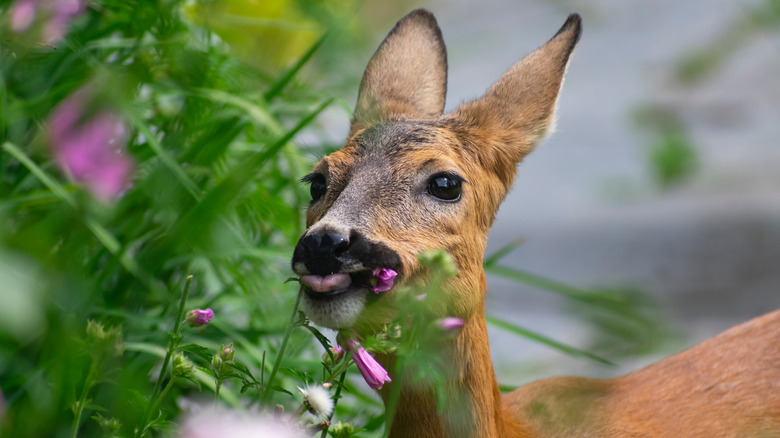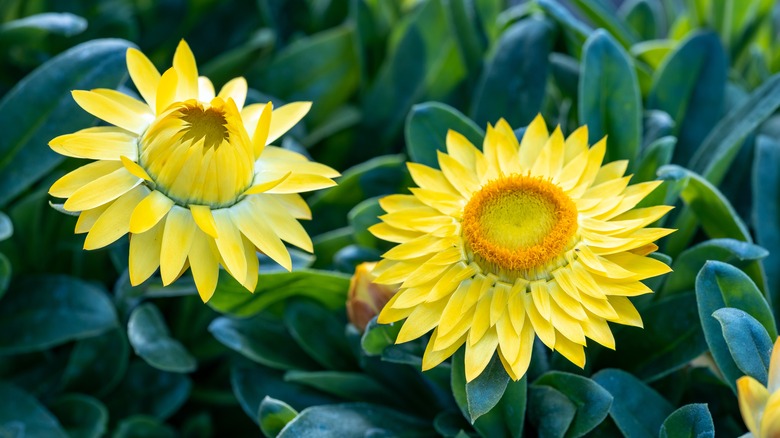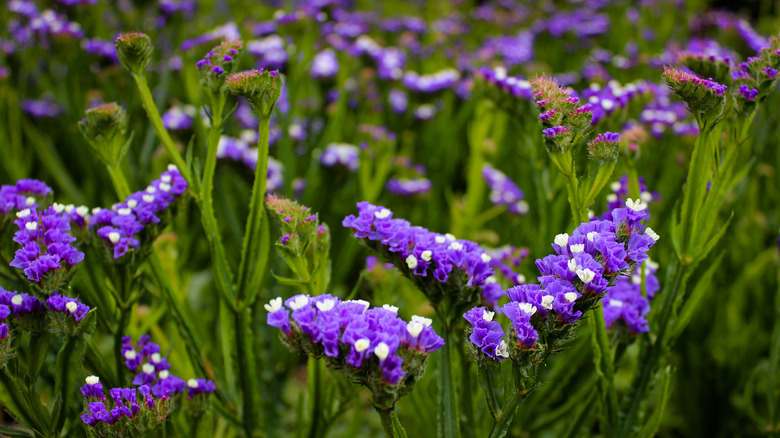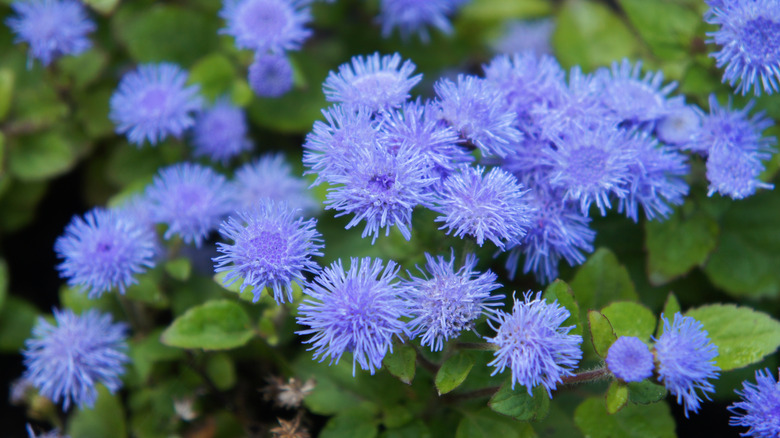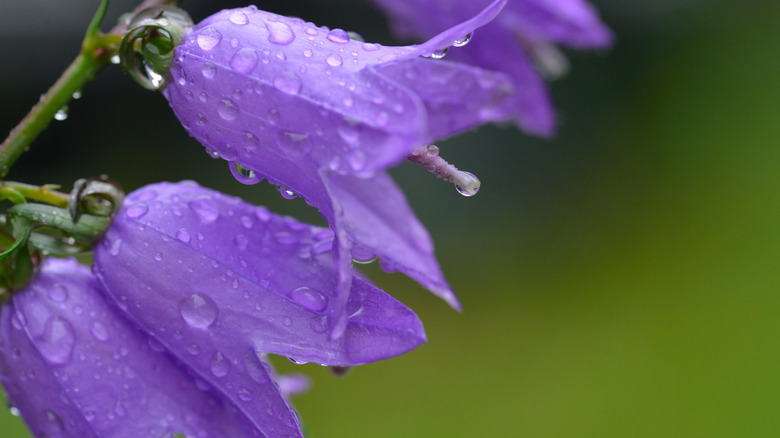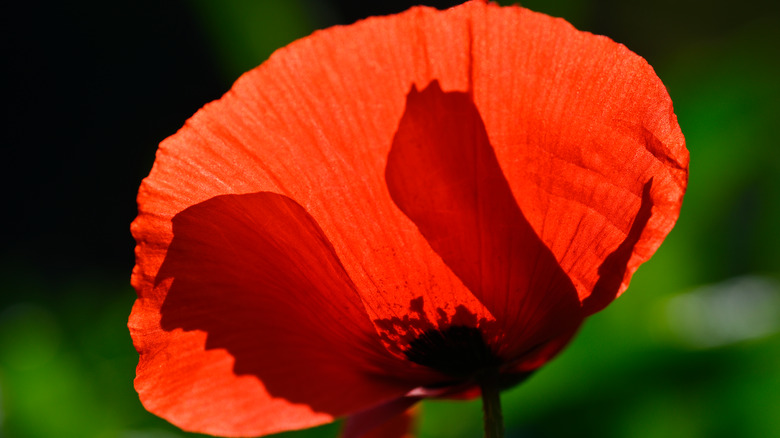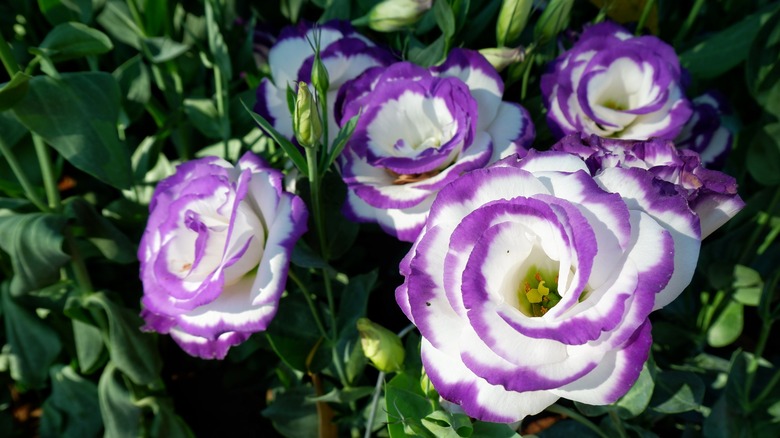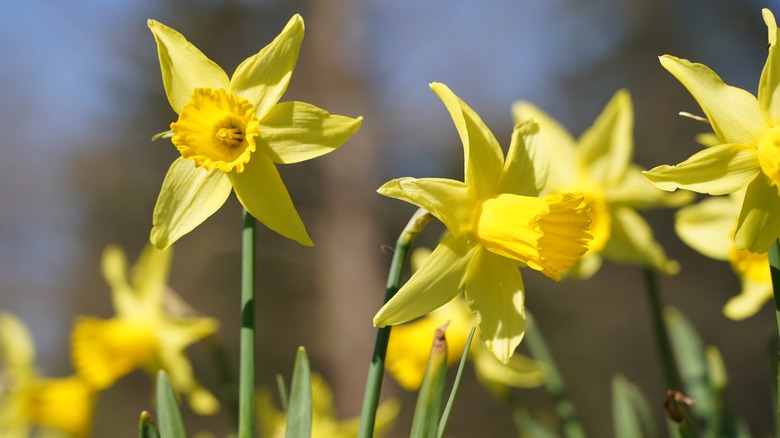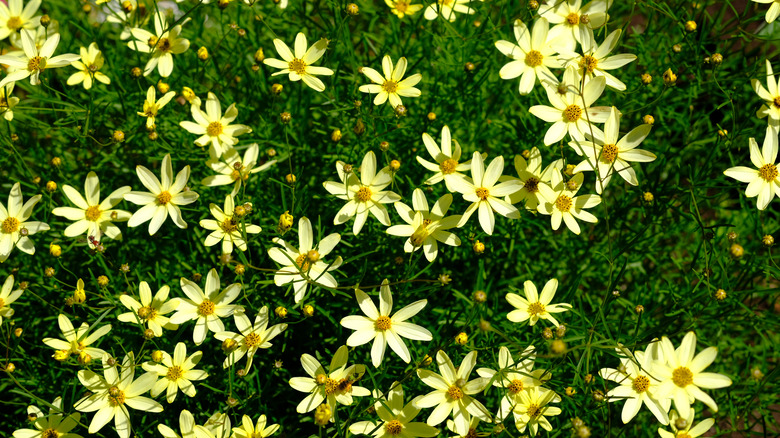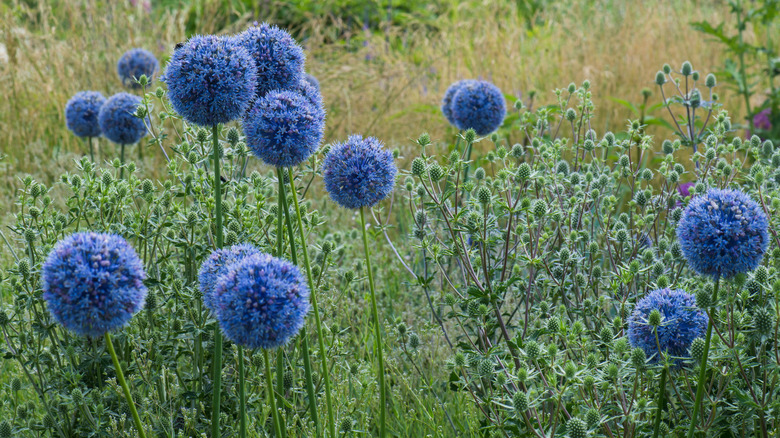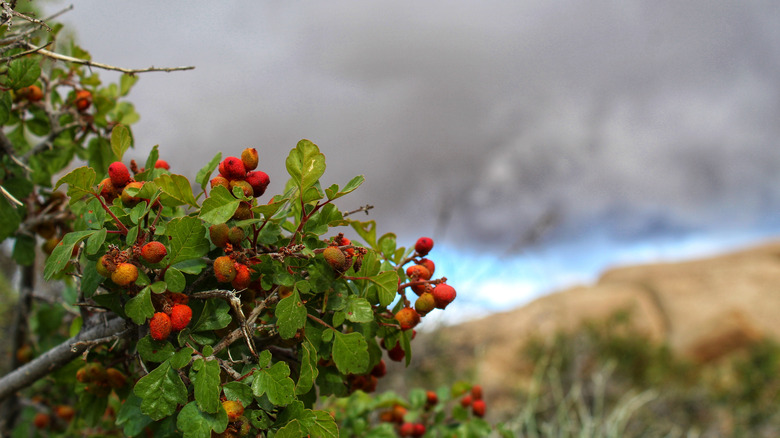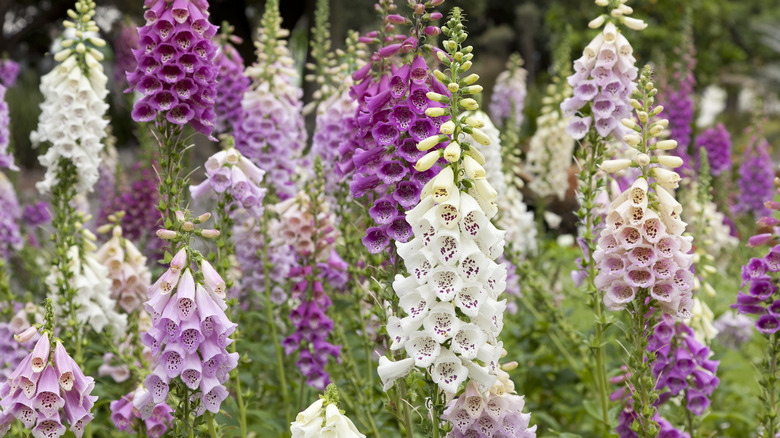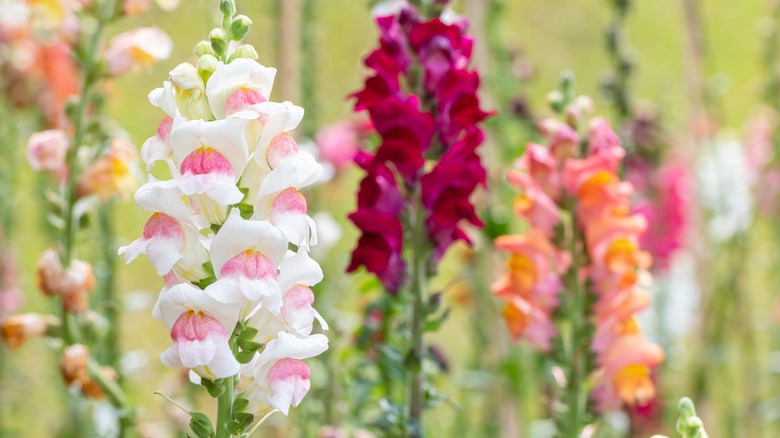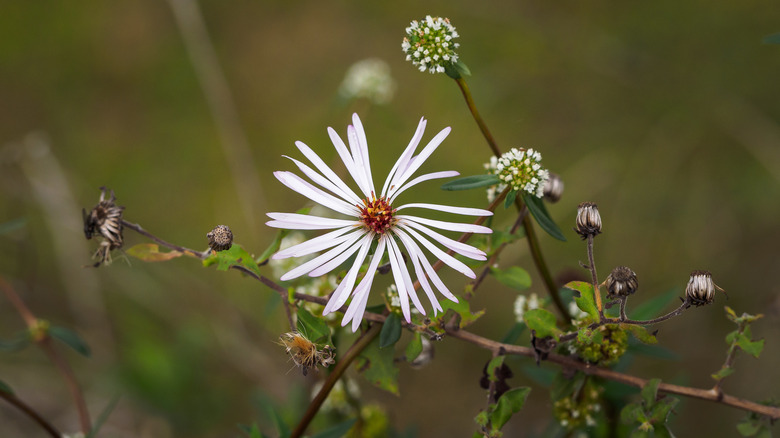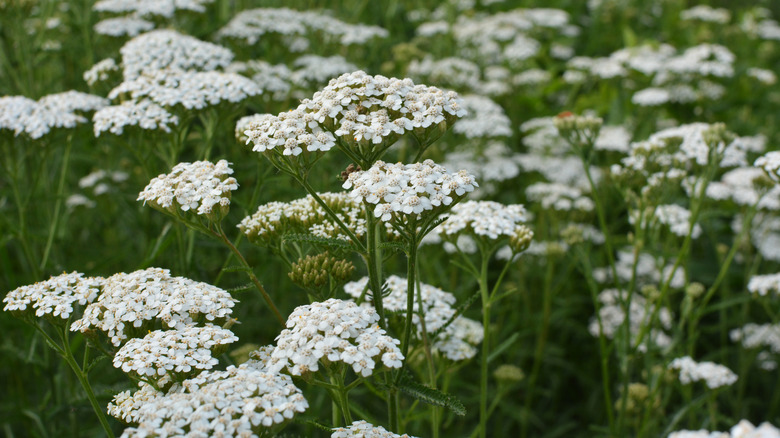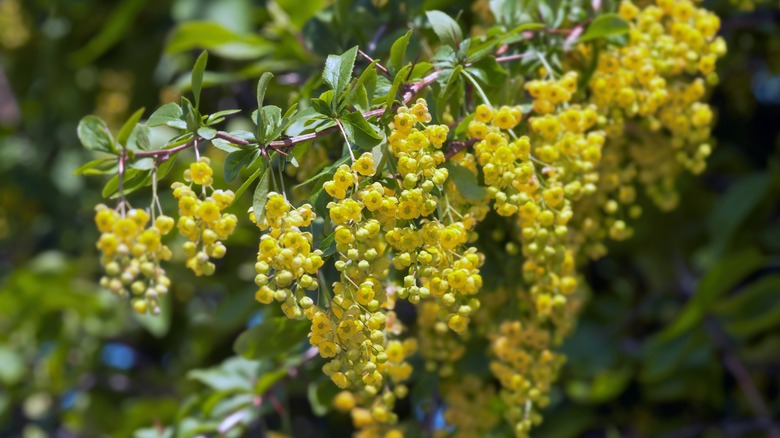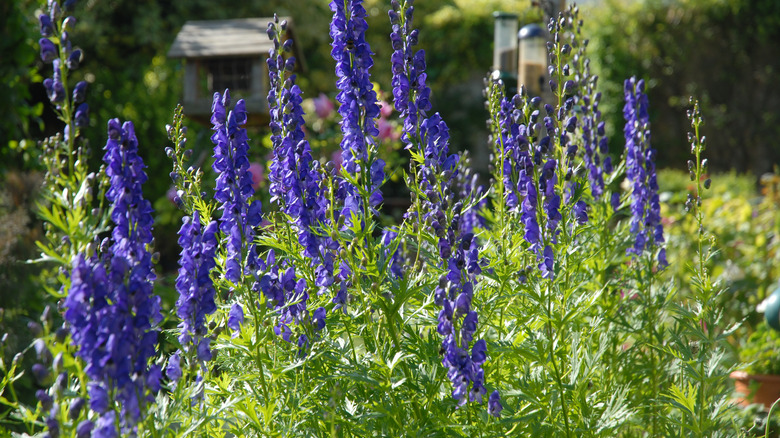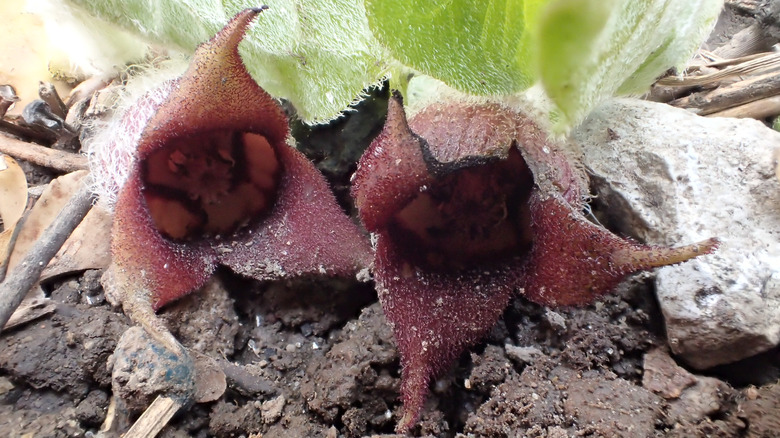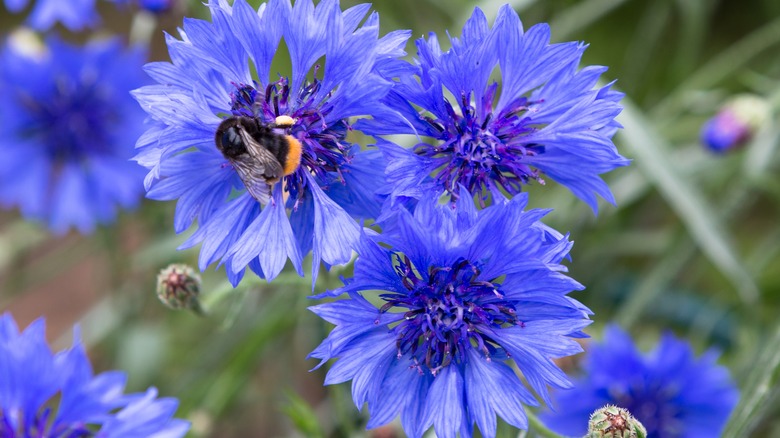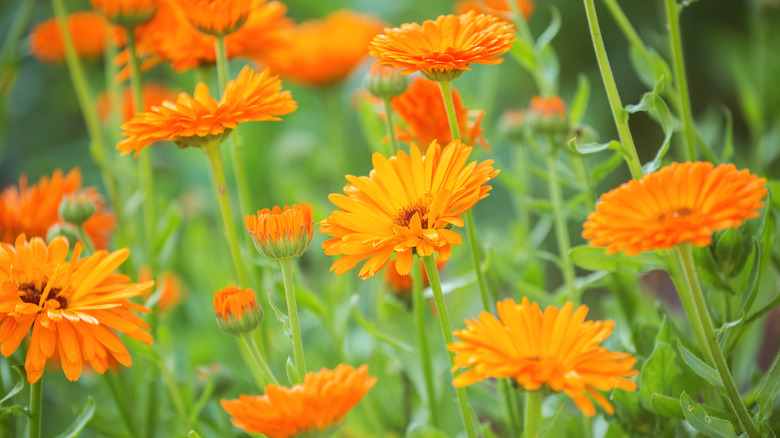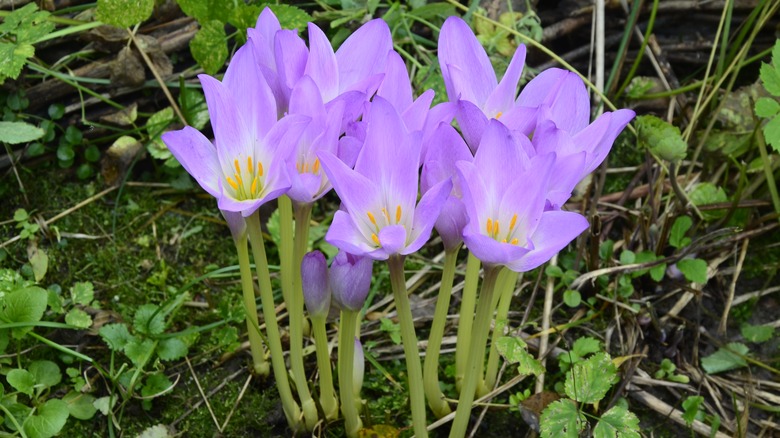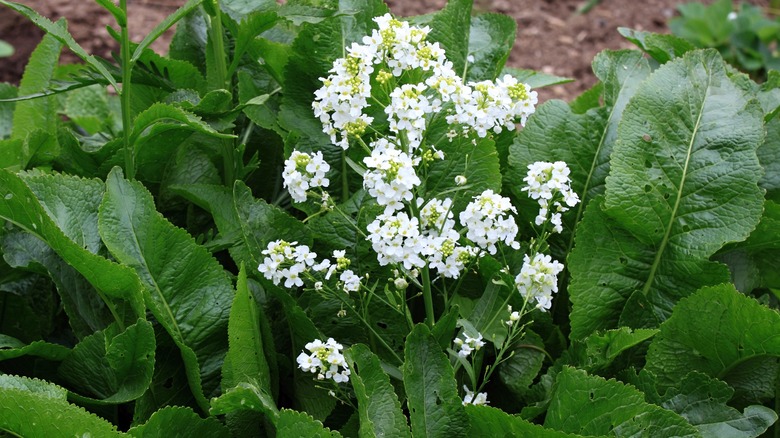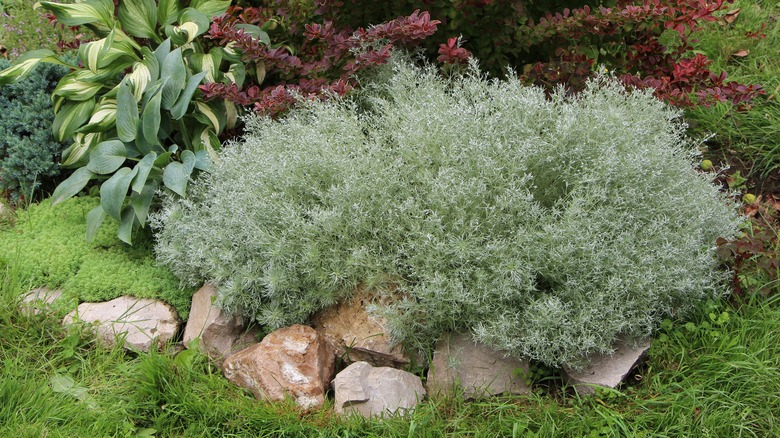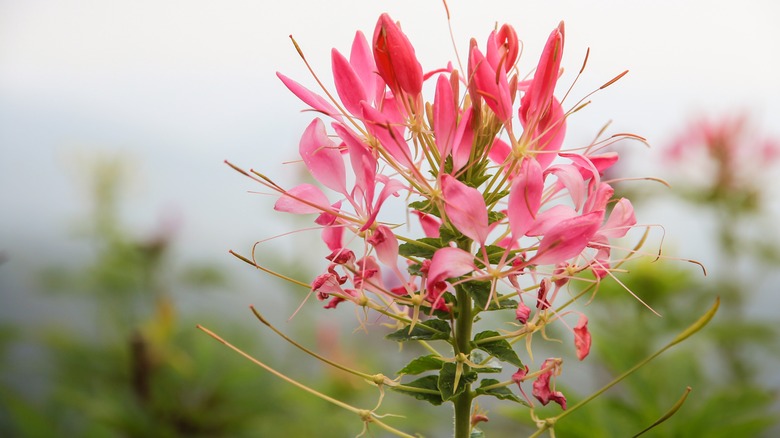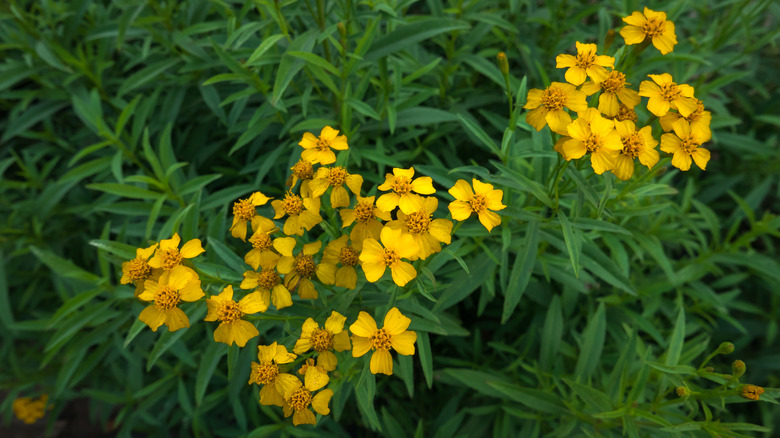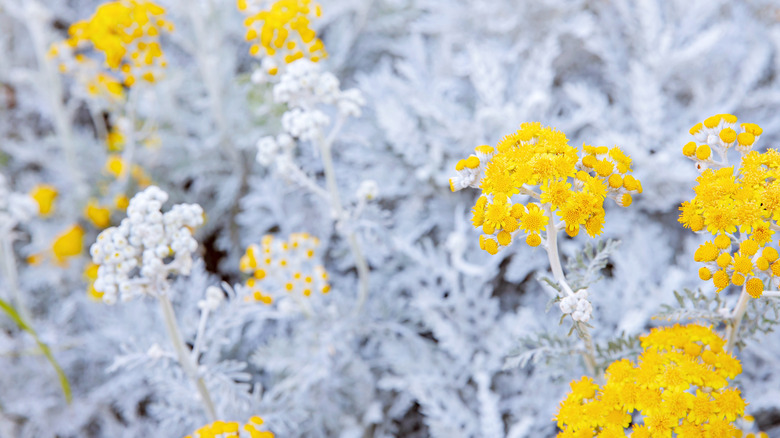The Best Flowering Plants For Your Garden That Are Deer-Resistant
New gardeners tend to make the same mistake when they start, leading to a ravaged garden bed full of half-eaten plants. The culprits? Mammalian herbivores, which are most often deer. Deer live in every state in the United States, typically near forested areas. According to the University of Georgia Extension, their favorite garden plants are fertilized, tender, and succulent vegetation such as hostas, daylilies, and impatiens. If you have a problem with deer grazing in your garden, you might consider sacrificing flowering plants such as these for more deer-resistant flowers.
You should keep in mind that no plant is truly deer-proof, and if one of these animals is desperate enough, it will eat the so-called "deer-tolerant" plants covered in spines and hair or have toxic properties. Still, by planting ornamental and edible plants that deer are usually repulsed by, you can minimize the damage you might sustain from hungry herbivores. In this collection of stunning flowering plants, we've gathered many great options for your garden if you are experiencing a deer problem.
1. Strawflower
Strawflowers (Xerochrysum bracteatum), also known as everlasting flowers, are members of the daisy family. Like daisies, these flowers have an erect growth habit and paper-like petals. They make for excellent cut flowers, as per The Royal Horticultural Society. When growing these in your garden, always plant them in well-draining soil with access to direct sunlight.
Bloom Season: Summer to fall
USDA Growing Zone: 8 to 10
Growing Conditions: Full sun to partial shade
Soil Type: Well-draining
Size: 1 to 5 feet tall and 6 to 18 inches wide
2. Statice
Statice or sea lavender (Limonium sinuatum) is a Mediterranean plant with papery blooms that form in clusters. The flowers can be pink, purple, blue, yellow, red, or white. Deer typically prefer to eat plants without hairs, spines, and bristles. According to North Carolina Extension Gardener Plant Toolbox, this plant's leaves and stems are covered with tiny hairs, so it will keep feeding mammals away.
Bloom Season: Spring
USDA Growing Zone: 8 to 11
Growing Conditions: Full sun
Soil Type: Well-draining sandy loam
Size: 2 feet tall and 1 foot wide
3. Ageratum
The flossflower or ageratum flower (Ageratum houstonianum) is an unusual plant showing fluffy flowers that may be light purple, white, or soft pink. These pastel colors are considered somewhat rare in the garden, especially blue. The University of Wisconsin-Madison Division of Extension suggests using the flowers for edging or border plantings; however, they can also be used in containers.
Bloom Season: Late spring to late fall
USDA Growing Zone: 2 to 11
Growing Conditions: Full sun
Soil Type: Moist and well-draining
Size: 6 to 30 inches tall
4. Bluebell bellflower
The bluebell bellflower (Campanula rotundifolia) is incredibly beautiful. The flowers feature five petals arranged in a star shape, colored with a light blue to purple hue. These bell-like blooms appear in the summer and last until fall, as told by Prairie Nursery. Don't let their delicate appearance fool you. They are highly drought-tolerant and deer-resistant and can grow in challenging soil.
Bloom Season: Summer and fall
USDA Growing Zone: 2 to 7
Growing Conditions: Full sun
Soil Type: Well-drained sand or gravel
Size: 1 to 2 feet tall
5. Poppy flowers
Poppies (Papaver rhoeas) are known for their showy, saucer-shaped flowers that bloom on tall stems. This species is best grown in warmer climates. However, no matter where you grow them, they will act as an annual, says North Carolina Extension Gardener Plant Toolbox. The blooms of the plant last only a day, but groups of poppies will bloom profusely throughout the season so that you won't lose any obvious color.
Bloom Season: Spring and fall
USDA Growing Zone: 3 to 10
Growing Conditions: Full sun
Soil Type: Well-draining
Size: 2 to 3 feet tall and 1 to 3 feet wide
6. Lisianthus
Lisianthus (Eustoma grandiflorum) grows best in climates that are not too cold. You can find them growing wild in prairies and fields in the midwest, as said by Missouri Botanical Garden. The plants' gorgeous flowers are long bloomers that appear in the summer and last until frost. When you're looking to keep deer away from your plants, grow these near the front of your garden to ward them off.
Bloom Season: Summer to winter
USDA Growing Zone: 8 to 10
Growing Conditions: Full sun
Soil Type: Well-draining
Size: 1 to 3 feet tall
7. Wild daffodil
Wild daffodils (Narcissus pseudonarcissus) are a popular addition to any spring garden, as they bloom early and their flowers last for weeks. Other great aspects of this plant are its ability to grow in poor soil, bloom in the snow, and deter deer, rabbits, and other destructive animals, as per Longfield Gardens.
Bloom Season: Early to late spring
USDA Growing Zone: 3 to 8
Growing Conditions: Full sun to partial shade
Soil Type: Well-draining
Size: 6 to 16 inches tall
8. Threadleaf coreopsis
Threadleaf coreopsis (Coreopsis verticillata) is named for its extremely thin foliage-like pieces of thread. The unique leaves are ornamental on their own, but they are outshined by their flowers that bloom in the summer. As described by North Carolina Extension Gardener Plant Toolbox, an adaptable plant, threadleaf coreopsis can grow in a range of soils and is tolerant of heat, humidity, and salt.
Bloom Season: Summer
USDA Growing Zone: 3 to 9
Growing Conditions: Full sun to partial shade
Soil Type: Well-draining chalk, loam, or sand
Size: 2 to 3 feet tall and wide
9. Ornamental onion
Blue globe onion or ornamental onion (Allium caeruleum) dissuades deer from snacking on your garden with its pungent onion or garlic-like scent that repulses the animal. In your yard, the flower stem grows relatively tall, and it's topped with a spherical blue-lavender blossom near spring's end, as American Meadows mentioned.
Bloom Season: Summer
USDA Growing Zone: 4 to 8
Growing Conditions: Full sun
Soil Type: Rich and well-draining
Size: 14 to 16 inches tall and 6 to 12 inches wide
10. Fragrant sumac
Fragrant sumac (Rhus aromatica) scares off deer the same way that ornamental onions do. The leaves of the low-growing groundcover species smell similar to citrus when crushed or rubbed against. Monrovia notes that the fragrant sumac plant should be grown in well-draining soil, and it will need water each time the top 3 inches of its soil dries out.
Bloom Season: Spring
USDA Growing Zone: 4 to 9
Growing Conditions: Full sun to partial shade
Soil Type: Average and well-draining
Size: 2 to 6 feet tall and 6 to 10 feet wide
11. Foxglove
Foxglove (Digitalis purpurea) is a poisonous flowering plant frequently used for deterring animals looking to feast on edible plants. The flowers are beautiful and borne on tall stalks above the foliage. The most poisonous part of the plant is the leaves, as said by Missouri Botanical Garden, which are also covered in fuzzy hairs that adequately shoo away animals before they get a taste.
Bloom Season: Spring
USDA Growing Zone: 4 to 8
Growing Conditions: Full sun to partial shade
Soil Type: Well-draining
Size: 2 to 5 feet tall and 1 to 3 feet wide
12. Snapdragon
Snapdragons (Antirrhinum majus) can be identified by their glossy dark green stems and leaves that contrast with their multi-colored blooms. The flowers of the plant are very decorative, and they can appear yellow, white, pink, orange, or purple, as listed by the IFAS Extension of the University of Florida. In your garden, this flowering herbaceous annual should grow happily in well-draining soil when exposed to direct sunlight.
Bloom Season: Spring to fall
USDA Growing Zone: 2 to 11
Growing Conditions: Full sun to partial shade
Soil Type: Evenly moist and well-draining
Size: 6 inches to 3 feet tall, depending on the cultivar
13. Climbing aster
The Lady Bird Johnson Wildflower Center says that climbing asters (Ampelaster carolinianus) are vining plants with multi-petalled flowers and tangled stems. The climber can boast thin, woody branches as long as 12 feet and covered with pink to purple blooms in the summer and fall. Native to the U.S., climbing asters should be grown in warmer states, such as Florida and Georgia, in very moist soil.
Bloom Season: Summer and fall
USDA Growing Zone: 6 to 9
Growing Conditions: Full sun to partial shade
Soil Type: Moist clay or loam
Size: Taller than 10 feet tall, 3 to 6 feet wide
14. Common yarrow
Common yarrow (Achillea millefolium) is a commonly grown garden flower with a reputation for being resistant to many things, including deer, drought, floods, heavy clay soil, and salt, as explained by the California Native Plant Society. The flower is characterized by tall and upright stems that bloom with clusters of small and fragrant flowers in yellow, white, or pink throughout the summer and fall.
Bloom Season: Mid-spring to early fall
USDA Growing Zone: 4 to 8
Growing Conditions: Full sun to partial shade
Soil Type: Nutrient-poor and dry
Size: 2 to 3 feet tall and 1 foot wide
15. Common barberry
The common barberry plant (Berberis vulgaris) is a shrub species with a somewhat weedy growth habit. The plant is well-known for its odor emitted by flowers that appear in the spring. These flowers are small and yellow with some ornamental value. Near the end of summer, they give way to red berries eaten by birds, as told by the North Carolina Extension Gardener Plant Toolbox.
Bloom Season: Spring and summer
USDA Growing Zone: 3 to 7
Growing Conditions: Full sun to partial shade
Soil Type: Evenly moist and well-draining
Size: Up to 13 feet tall
16. Monkshood
Monkshood (Aconitum napellus), also known as wolfsbane, is another poisonous herb with stunning flowers. The seeds and roots are the most toxic part of the plant, and deer and rabbits know to keep their distance from all the plant's parts to avoid its toxins. Missouri Botanical Garden warns gardeners to wear protective clothing and gloves when working with monkshood as the plant's juices can cause adverse reactions.
Bloom Season: Mid to late summer
USDA Growing Zone: 3 to 7
Growing Conditions: Full sun to partial shade
Soil Type: Well-draining
Size: 2 to 4 feet tall
17. Wild ginger
Wild ginger (Asarum canadense) is an edible and fragrant plant you can grow in your garden as a functional addition or an ornamental specimen. Cornell Botanic Gardens depicts the ginger plant as a shade-loving perennial with a short-growth habit and states that local herbivores will avoid the plant's moderately toxic foliage. The roots and leaves are fragrant with the scent of ginger which is welcomed by most.
Bloom Season: Spring
USDA Growing Zone: 4 to 6
Growing Conditions: Partial to full shade
Soil Type: Evenly moist and well-draining
Size: 4 to 6 inches tall
18. Cornflower
Cornflowers (Centaurea cyanus) have a long list of common names. You might know them as bluebonnets, corn binks, happy skies, witch's bells, bluets, or another name. The Royal Horticultural Society illustrates this plant as an upright annual with thistle-like blooms that only appear in blue. They grow well in the warmer months in most climates and are unfussy about their soil as long as it is well-draining.
Bloom Season: Spring and summer
USDA Growing Zone: 2 to 11
Growing Conditions: Full sun
Soil Type: Well-draining
Size: 1 to 3 feet tall and 1 to 2 feet wide
19. Pot marigold
Pot marigolds (Calendula officinalis) are a popular flower for growing during the fall. They are not related to the Tagetes genus, which is home to other species with the same common name. The University of Wisconsin-Madison Division of Extension states that pot marigolds are frequently grown in flower gardens as an edible herb. The flowers can be used in salads, medicine, dye, and cosmetics.
Bloom Season: Spring to fall
USDA Growing Zone: 2 to 11
Growing Conditions: Full sun to partial shade
Soil Type: Moist and well-draining
Size: 1 to 2 feet tall and wide
20. Autumn crocus
Autumn crocus (Colchicum autumnale) is another perfect fall flower used for keeping deer away from your garden. According to Jefferson Monticello, it is identified as an irritant and a toxic plant. The flowers are bell-shaped and quite decorative, and they bloom just as fall begins and show off a delicate purple hue. Use this species as edging near plants that are less deer-resistant for a beautiful display of color.
Bloom Season: Fall
USDA Growing Zone: 4 to 8
Growing Conditions: Partial shade
Soil Type: Rich and well-draining
Size: 6 to 9 inches tall and wide
21. Flowering horseradish
Even if you aren't a fan of horseradish alongside your beef or fish, flowering horseradish (Armoracia rusticana) could still be a delightful plant to add to your garden. Minnesota Wildflowers depicts the flowers as white spring bloomers with a short width. They cluster together at the top of the plant's erect stems and enjoy exposure to direct sunlight.
Bloom Season: Summer
USDA Growing Zone: 4 to 8
Growing Conditions: Full sun
Soil Type: Evenly moist and well-draining
Size: 2 to 3 feet tall
22. Silver mound
Silver mound (Artemisia schmidtiana) is named for its color and growth habit. Herbaceous and semi-evergreen, this plant is known to deter deer and other mammalian herbivores like rabbits from snacking on its foliage. Keep in mind that the silver mound plant is toxic and should be kept away from children and pets. Monrovia suggests planting it as a border, groundcover, or accent plant.
Bloom Season: Summer
USDA Growing Zone: 3 to 9
Growing Conditions: Full sun
Soil Type: Well-draining
Size: 6 to 12 inches tall and 12 to 18 inches wide
23. Spider flower
The spider flower (Cleome hassleriana), not to be confused with the spider plant, is a tender annual named for its flowers with thin petals that look like spiders, as announced by the University of Wisconsin-Madison Division of Extension. The stems and leaves of the spider flower are thorny and sticky, which makes them unappealing to deer and rabbits.
Bloom Season: Summer to fall
USDA Growing Zone: 10 to 11, everywhere else as an annual
Growing Conditions: Full sun
Soil Type: Evenly moist and well-draining
Size: 1 to 5 feet tall
24. Tarragon
The tarragon plant (Artemisia dracunculus) is an edible herb disliked by deer. It is usually grown for its leaves which can be used as a spice or medicine. The herbaceous perennial has a natural scent that is likened to anise. Missouri Botanical Garden recommends planting it in an herb garden with rich and well-draining soil. Your tarragon plant will grow happily alongside other tasty plants like chives and sage.
Bloom Season: Summer
USDA Growing Zone: 3 to 7
Growing Conditions: Full sun
Soil Type: Rich and well-draining
Size: 1 to 3 feet tall and wide
25. Dusty miller
Dusty miller plants (Jacobaea maritima) are interesting annual subshrubs with silver to white foliage and bright yellow flowers in the summer. The leaves of this plant are lobed and rounded and are known to be deer-resistant. You can quickly grow this plant in nearly any type of garden as it is adaptable to a range of soils and hardy to USDA zone 7, as noted by The Royal Horticultural Society.
Bloom Season: Summer
USDA Growing Zone: 7 to 10
Growing Conditions: Full sun to partial shade
Soil Type: Moist and well-draining
Size: 6 to 18 inches tall and wide
